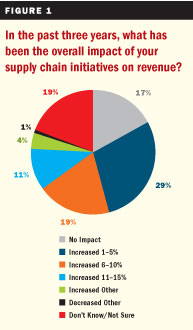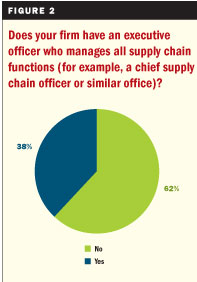Leading Supply Chain Traits
Consumer goods firms identified as supply chain "leaders" have specific characteristics that position them for competitive advantage, according to the fifth annual 2007 Global Survey of Supply Chain Progress conducted by CSC, Supply Chain Management Review and Michigan State University (MSU). The survey, completed by supply chain professionals, identifies collaboration as a major differentiator between consumer goods firms in three levels of maturity: leaders, followers and laggards. In addition to collaboration, leader traits include: the designation of a chief supply chain officer, a strong connection between supply chain and information technology (IT) organizations, the strategic use of technology, and the incorporation of supply chain planning and strategy into the business plan.
The survey documents the differences between mature, moderately mature and immature consumer goods firms along eight dimensions of supply chain competence. Comparing the practices and performance of the responding firms indicated that companies tend to fit into one of three groups: leaders, followers and laggards. The dimensions of supply chain competence are:
- Alignment with business strategy
- Strategic customer integration
- Strategic supplier integration
- Cross-functional internal integration
- Supply chain responsiveness
- Planning and execution process and technology
- Supply chain rationalization/segmentation
- Risk management
Variations in profiles were developed to determine the specific characteristics of firms in the three levels of maturity. The variations in these profiles outline what must be done to move from one level to the next, and what benefits can be achieved from taking these steps. The difference can be as much as two to three points of bottom line profit.
KEY LEARNINGS
While collaboration continues to be a major focus among supply chain professionals, it appears to be a mark only of the leading consumer goods firms, which are willing to share valuable knowledge that helps network partners. Supplier-retailer collaboration remains a rare phenomenon.
While collaboration continues to be a major focus among supply chain professionals, it appears to be a mark only of the leading consumer goods firms, which are willing to share valuable knowledge that helps network partners. Supplier-retailer collaboration remains a rare phenomenon.
Inventory management is still an elusive concept among consumer goods firms. Despite gains made by leaders in using visibility, better S&OP techniques, and cooperative matching of demand with supply, followers and laggards remain focused on retaining extra inventory to respond quickly to unexpected needs.
Consumer goods firms must invest more in changing key processes and technology areas to become demand driven and responsive. The evidence and technology are available, and are being used successfully by the leaders.
Leading practices start with co-analyzing consumer demand, buyer preferences and trends, and then jointly building appropriate supply chain responses. This concept is only practiced on an enterprise-wide basis today by a few leaders.
SURVEY RESULTS
Results from the 2007 Global Survey of Supply Chain Progress indicate consumer goods firms remain determined to use attention on supply chain as a means to reduce costs, with such efforts showing improvements in terms of savings generated. Seventy percent of respondents indicated costs savings from 1 percent to 5 percent to as high as 15 percent or more. Leaders were showing greater gains and more progress with revenue increases. More than 40 percent of the leaders indicated at least 6 percent gains in revenues attributable to supply chain initiatives (see Figure 1).
Results from the 2007 Global Survey of Supply Chain Progress indicate consumer goods firms remain determined to use attention on supply chain as a means to reduce costs, with such efforts showing improvements in terms of savings generated. Seventy percent of respondents indicated costs savings from 1 percent to 5 percent to as high as 15 percent or more. Leaders were showing greater gains and more progress with revenue increases. More than 40 percent of the leaders indicated at least 6 percent gains in revenues attributable to supply chain initiatives (see Figure 1).
Among the interesting patterns discovered, the consumer goods firms making greater progress have moved from a cost-only perspective to more customerfocused objectives -- such as faster and more personalized order fulfillment, shorter order fulfillment lead times, creating and delivering perfect orders, and enhanced cash-to-cash cycle and asset turns. Leaders also have a greater correlation between executive involvement and development of specific supply chain plans that become an integral part of corporate strategy and planning system. An absence of such a connection is a characteristic of less mature firms.
Interesting results occurred when we asked: Does your firm have an executive officer who manages all supply chain functions? Nearly 40 percent responded affirmatively, while 62 percent answered negatively (see Figure 2).
 |  |
CALL FOR ACTION
Based on the responses, several observations are appropriate:
Based on the responses, several observations are appropriate:
- Supply chain management continues to meet with mixed results, although general progress is evident.
- There must be someone in charge, with full responsibility for what happens across the extended enterprise. This senior officer reports directly to the CEO and has the full support of the CIO and CFO to optimize results.
- A large opportunity exists for financial officers to be more involved in supply chain efforts, particularly around the actual improvements that can be made to financial performance.
- Making progress with revenue increases, as well as cost reductions is a real opportunity that the leaders use to establish advantage.
- IT must continue its progression from a necessary evil to a strategic differentiator.
- Getting the process right must come first, followed by successful enablement through application of the correct software and technology
Attention to supply chain improvement is no longer a casual effort intended to bring some quick returns to financial performance. It's a way of business life for consumer goods firms. The leaders are paving the way to a more profitable future, while the followers and laggards are trying to get their act together. For a comprehensive report on the 2007 survey, please visit www.csc.com. CGT
